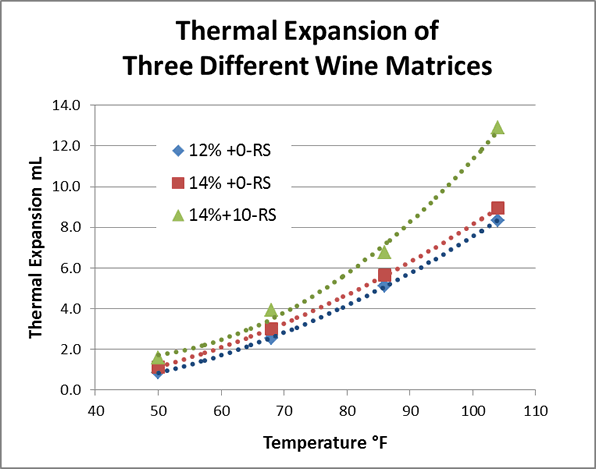| Thermal Expansion Calculation | ||||||||||||||||||||||||||||||
Thermal Expansion is a critical factor in calculating fill heights during bottling. The most common miscalculation occurs when wineries do not compensate for bottling at cooler temperatures than the eventual storage conditions. This can lead to underestimating the headspace. For instance, wine bottled at 50°F will see approximately 2ml of headspace disappear at normal storage temperature of 68°F. Failing to take this expansion into consideration can lead to serious over pressure if the wine is exposed, for even several hours, to higher than normal storage temperatures. Thermal Expansion is affected by attributes of the wine matrix. As these values show, the thermal expansion of wine does not follow in a straight line but increases more steeply at higher temperatures. This display shows the expansion curve for three wine types:
The difference between 12% and 14% appears negligible and the Ullage calculator is based on the 14% performance with a starting point of 68F. The wine tested with 10% RS showed significantly higher expansion, especially at temperatures over 70°F. At 86°F this wine would "lose" 3.75mL of headspace compared to a wine with the same alcohol and dry finish at 68°F. This research does not demonstrate if this is behavior is caused by sugar itself, or some other properties yielding higher specific gravities. The CQC suggests that wineries should choose a conservative ullage number, as high as possible, for wines with high specific gravity. |
||||||||||||||||||||||||||||||
A Technical Note from AWRI cites: Levreau, R., Lefebvre, A., Serrano, M., Ribereau-Gayon, P Etude du bouchage liege 1. Role des supressions dans l’apparitions des ‘bouteilles couleuses’, bouchage sous gaz carbonique Connais. Vigne Vin 11:351-77, 1977. Summary seen below. |
||||||||||||||||||||||||||||||
 |
||||||||||||||||||||||||||||||
Calculations for liquid expasion were developed from the regression analyses of the observed expansion values at 10,20,30 and 40°C. Reported values were adjusted to reflect their difference from values observed at the standard wine storage temperature 20°C.
|
||||||||||||||||||||||||||||||
|
||||||||||||||||||||||||||||||